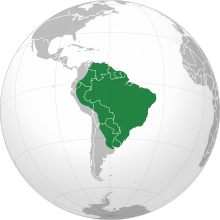| Capybara | |
|---|---|

| |
| In Petrópolis, Brazil | |
| Scientific classification | |
| Domain: | Eukaryota |
| Kingdom: | Animalia |
| Phylum: | Chordata |
| Class: | Mammalia |
| Order: | Rodentia |
| Family: | Caviidae |
| Genus: | Hydrochoerus |
| Species: | H. hydrochaeris
|
| Binomial name | |
| Hydrochoerus hydrochaeris | |

| |
| Native range | |
| Synonyms | |
|
Sus hydrochaeris Linnaeus, 1766 | |
The capybara[a] or greater capybara (Hydrochoerus hydrochaeris) is the largest living rodent,[2] native to South America. It is a member of the genus Hydrochoerus. The only other extant member is the lesser capybara (Hydrochoerus isthmius). Its close relatives include guinea pigs and rock cavies, and it is more distantly related to the agouti, the chinchilla, and the nutria. The capybara inhabits savannas and dense forests, and lives near bodies of water. It is a highly social species and can be found in groups as large as 100 individuals, but usually live in groups of 10–20 individuals. The capybara is hunted for its meat and hide and also for grease from its thick fatty skin.[3]
- ^ Reid, F. (2016). "Hydrochoerus hydrochaeris". IUCN Red List of Threatened Species. 2016: e.T10300A22190005. doi:10.2305/IUCN.UK.2016-2.RLTS.T10300A22190005.en. Retrieved 19 November 2021.
- ^ Basic Biology (2015). "Rodents".
- ^ Capybara (Hydrochoerus hydrochaeris) Archived 2012-01-03 at the Wayback Machine. ARKive.org
Cite error: There are <ref group=lower-alpha> tags or {{efn}} templates on this page, but the references will not show without a {{reflist|group=lower-alpha}} template or {{notelist}} template (see the help page).
